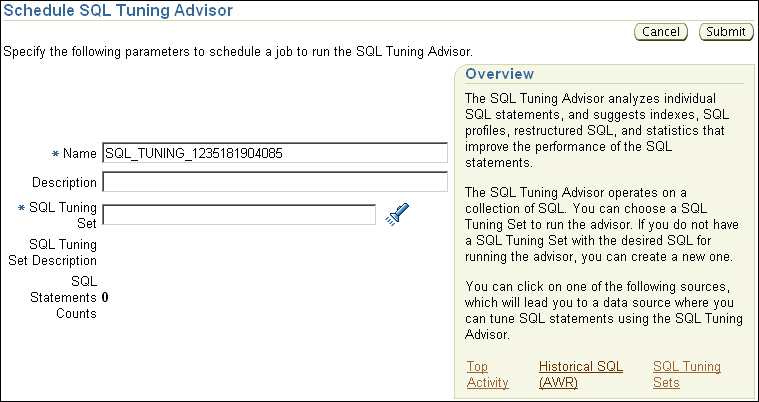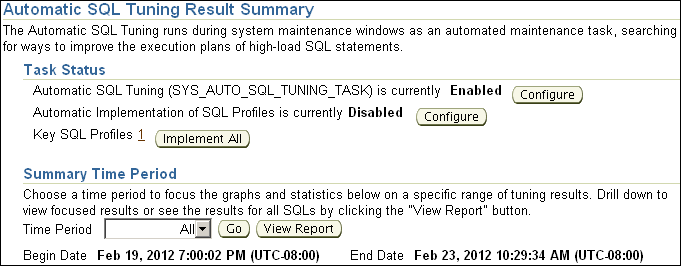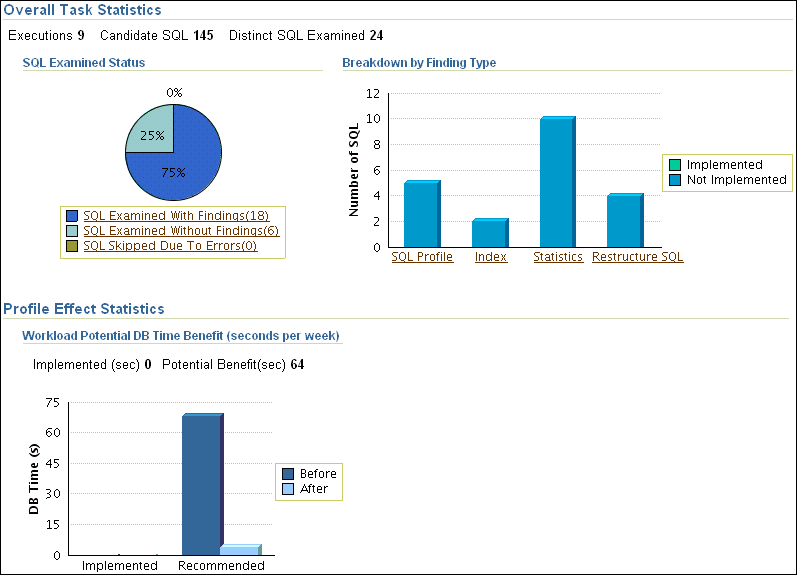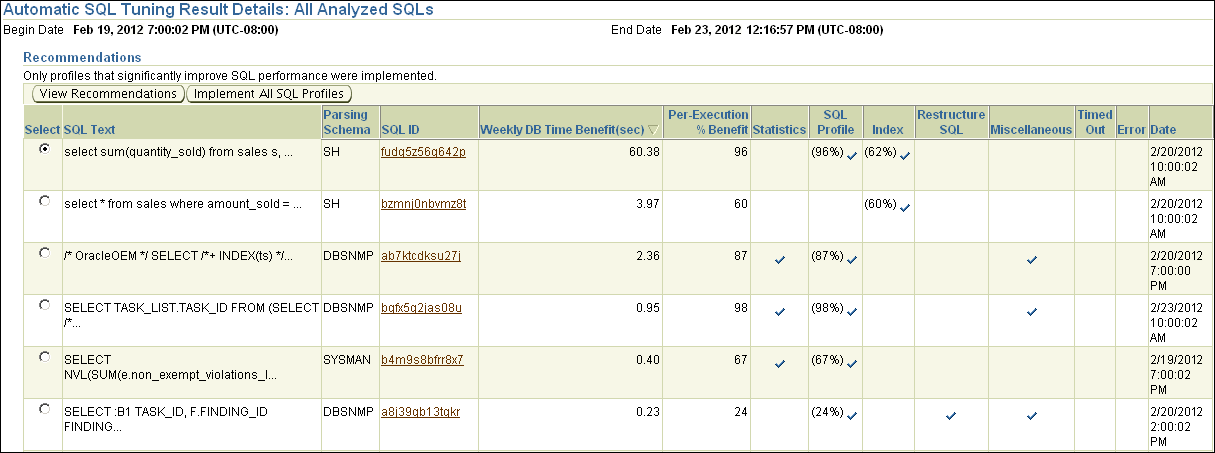About Tuning SQL Statements
A SQL statement specifies the data you want Oracle Database to retrieve.
Execution plan(which the optimizer is responsible for generating): The access method for physically executing a SQL statement
The optimizer determines whether it is more efficient to read all data in the table, called a full table scan, or use an index. It compares the cost of all possible approaches and chooses the approach with the least cost.
The query optimizer can also help you tune SQL statements. By using SQL Tuning Advisor and SQL Access Advisor, you can run the query optimizer in advisory mode to examine a SQL statement or set of statements and determine how to improve their efficiency. SQL Tuning Advisor and SQL Access Advisor can make various recommendations, such as the following:
-
Creating SQL profiles
-
Restructuring SQL statements
-
Creating additional indexes or materialized views
-
Refreshing optimizer statistics
12.1 Tuning SQL Statements Using SQL Tuning Advisor
You can use SQL Tuning Advisor to tune one or more SQL statements. When tuning multiple statements, SQL Tuning Advisor does not recognize interdependencies between the SQL statements. Instead, SQL Tuning Advisor provides a convenient way to obtain tuning advice for a large number of SQL statements.
Oracle Database can generate SQL tuning reports automatically. Automatic SQL Tuning runs during system maintenance windows as an automated maintenance task, searching for ways to improve the execution plans of high-load SQL statements. A maintenance window is a contiguous time interval during which automated maintenance tasks are run.
12.1.1 Tuning SQL Manually Using SQL Tuning Advisor
Automatic Database Diagnostic Monitor (ADDM) automatically identifies high-load SQL statements. If ADDM identifies such statements, then click Schedule/Run SQL Tuning Advisor on the Recommendation Detail page to run SQL Tuning Advisor.
To tune SQL statements manually using SQL Tuning Advisor:
- Access the Database Home page. --->
- Performance menu,select Advisors Home --->
-
In the Advisors section, click SQL Advisors. The SQL Advisors page appears. -->
-
In the SQL Tuning Advisor section, click SQL Tuning Advisor. --->
-
In the Name field, enter a name for the SQL tuning task. ---->

12.1.2 Viewing Automatic SQL Tuning Results
By analyzing data in the Automatic Workload Repository (AWR), the database can identify routine maintenance tasks. The automated maintenance tasks infrastructure (known as AutoTask) schedules these tasks to run in maintenance windows.
Maintenance windows are Oracle Scheduler time intervals that belong to the window group named MAINTENANCE_WINDOW_GROUP. By default, one window is scheduled for each day of the week. You can customize attributes of these maintenance windows, including start and end times, frequency, and days of the week.
By default, AutoTask runs the following automated maintenance tasks in all maintenance windows:
-
Optimizer Statistics Collection
-
Segment Advisor
-
SQL Tuning Advisor
To view automatic SQL tuning results:
Access the Database Home page.-->From the Performance page, select Advisors Home. --->
Under Advisors, click SQL Advisors. --->Under SQL Tuning Advisor, click Automatic SQL Tuning Results.

---->In the Time Period list, select All and then click Go.

---->Optionally, in the Task Status section, click Configure to change the attributes of the Automatic SQL Tuning task.
---> In the Task Activity Summary section, leave All selected for the Time Period and then click View Report.

----> Under Recommendations, select a SQL statement and then click View Recommendations.
The Recommendations for SQL ID page appears.

12.2 Managing SQL Tuning Sets
A SQL tuning set is a database object that includes one or more SQL statements and their execution statistics and context. You can use the set as an input for advisors such as SQL Tuning Advisor, SQL Access Advisor, and SQL Performance Analyzer. You can load SQL statements into a SQL tuning set from different SQL sources, such as AWR, the cursor cache, or high-load SQL statements that you identify.
A SQL tuning set includes the following:
-
A set of SQL statements
-
Associated execution context such as:
-
User schema
-
Application module name and action
-
List of bind values
-
Cursor compilation environment
-
-
Associated basic execution statistics such as:
-
Elapsed time and CPU time
-
Buffer gets
-
Disk reads
-
Rows processed
-
Cursor fetches
-
Number of executions and number of complete executions
-
Optimizer cost
-
Command type
-
-
Associated execution plans and row source statistics for each SQL statement (optional)
12.2.1 Creating a SQL Tuning Set
To create a SQL tuning set:
- Specify the initial options for the SQL tuning set
- Select the load method to use for collecting and loading SQL statements into the SQL tuning set,
- Specify the filter options for the SQL tuning set
- Schedule and submit a job to collect the SQL statements and load them into the SQL tuning set
12.2.1.1 Creating a SQL Tuning Set: Options
- To specify options for creating a SQL tuning set:
- Access the Database Home page.
- From the Performance menu, select SQL, and then SQL Tuning Sets.
- Click Create.
- Enter the following details:
- In SQL Tuning Set Name, enter a name for the SQL tuning set.
- In Owner, enter the owner of the SQL tuning set.
- In Description, enter a description of the SQL tuning set.
- Optionally, to create an empty SQL tuning set and add SQL statements to it at a later time, complete the following steps:
相关文章
- mysql 查看优化器重写后的sql(explain extended和show warnings)
- 通过存储过程进行分页查询的SQL示例
- SQL SERVER 2012启动失败 because upgrade step 'SSIS_hotfix_install.sql' 失败
- SSMS 2005 连接 SQL SERVER 2008问题
- MS SQL 错误:无法绑定由多个部分组成的标识符 "xxxxx"
- SQL Server 中VARCHAR(MAX)变量赋值引起的性能问题。
- 【学习总结】SQL的学习-2-sql操作
- sql 语句系列(记录时间差)[八百章之第十八章]
- DBA常用SQL总结梳理
- [SQL] sql server中如何查看执行效率不高的语句
- mongodb sql-comparison
- 【Teradata SQL】统计连续三分钟发生交易次数10次以上的客户号
- SQL ALTER TABLE 语法
- SQL SERVER服务器链接连接(即sql server的跨库连接)
- SQL SERVER服务器链接连接(即sql server的跨库连接)
- SQL Server 2014 BI新特性(一)五个关键点带你了解Excel下的Data Explorer
- Atitit if else 选择决策流程ast对比 sql java 表达式类型 binaryExpression hase left and rit expr 目录 1.1. Sql1
- 数据库面试题【六、Sql的优化】
- SQL基础【二十、索引】(超细致版本,前理论,后实践,应对sql面试绰绰有余)
- 【SQL干货】一条sql按季度统计交易数据
- SQL删除重复数据方法
- SQL注入 Sqli-labs-Less-21(笔记)——还是回显注入 使用union select即可 但是要注意sql括号闭合 也可以报错注入
- SLS机器学习最佳实战:日志聚类+异常告警 —— 这个就是splunk SQL+机器学习结合产物啊
- SQL Server Management Studio工具备份数据表操作

